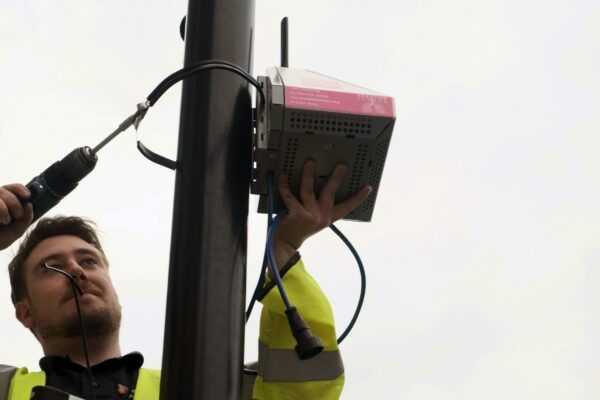You can’t manage what you can’t measure
Nine out of ten people breathe dirty air. Air pollution leads to early death and increased disease, while impacting our economies and reducing opportunities for our residents to thrive. The most vulnerable and marginalised communities in our cities are most at risk.
Air quality monitoring is a vital part of a city’s toolbox to improve urban air quality. Some cities have access to data from reference (or “regulatory-grade”) monitors – which are highly accurate but expensive. Other cities have little to no air quality information.
But a recent increase in more-affordable monitoring technologies has created new opportunities for cities of all resource levels. Diverse cities are using low-cost air quality sensors to monitor air pollution and develop actions to clean their air.
C40 Cities’ new air quality monitoring report highlights 11 cities that have deployed these sensors: Addis Ababa, Dar es Salaam, Denver, Lima, Lisbon, London, Los Angeles, Mumbai, Paris, Portland, and Quezon City. Here are four ways cities are using low-cost air quality sensors to achieve a range of goals.
1. Understanding pollution risk and air quality levels to meet health standards
So far, 48 mayors have pledged, in the C40 Clean Air Cities Declaration, to establish baseline air pollution levels and set ambitious targets that meet or exceed national commitments – in line with the World Health Organization’s (WHO) Air Quality Guidelines. The mayors have also committed to implementing new policies and programmes to address the top causes of air pollution emissions.
The WHO Air Quality Guidelines are based on global scientific evidence. When formulating policy targets, governments should consider their own local circumstances carefully before adopting these guidelines directly as legally-based standards.
Low-cost air quality sensors can provide the local baseline evidence that cities need to make the case for reducing emissions. In 2020, Quezon City Local Government partnered with C40 and Clean Air Asia to develop an air quality baseline study to support Mayor Joy Belmonte’s Clean Air Cities Declaration commitments. The baseline results provide insights that can be used to identify opportunities for clean air interventions. These interventions can then be integrated into the city’s air quality management plan to help Quezon City meet WHO air quality guidelines
2. Expanding public awareness while building evidence
Several cities are using data collected from their sensor monitoring networks to raise public awareness around the risks of pollution exposure. By creating an air quality sensor network, cities can make air quality data easily accessible to residents.
For example, the Breathe London pilot used sensors to evaluate air quality in London’s Ultra Low Emission Zone and School Streets projects. The Breathe London monitors detected changing levels of pollutants in locations far from regulatory monitors, providing new insights into local air quality and the potential for short-term air quality change.
This hyperlocal air pollution data is published on the Breathe London website to provide Londoners with a real-time picture of air pollution levels on their streets. Organisations, businesses and residents can host a sensor in their preferred location (for a fee). Community groups can apply to host a free sensor in a location of their choosing.
3. Uncovering impacts on marginalised people
Sensor networks can help evaluate air pollution exposure and risk among vulnerable and marginalised communities. The sensors provide important information that can help governments advance solutions to mitigate inequities and protect these communities.
Los Angeles’s sensor network was designed to empower residents of disadvantaged communities with data through collaborative approaches.
The City of Los Angeles and the 30+ community groups in the Transformative Climate Communities (TCC) Watts Rising collaborative created a hyperlocal air quality monitoring network to provide insights and learnings around one neighbourhood’s air quality.
The city installed sensors near parks and schools, and ran community outreach initiatives. Vulnerable populations, including children and seniors, were engaged and educated on monitoring air quality.
In October 2020, the Watts Rising air quality monitoring data portal was launched for residents. Periodic community meetings are being held to allow community members to ask questions about the data.
4. Increasing access to city-scale data and information platforms
The rapidly-expanding lower-cost air quality sensor market presents valuable opportunities for new urban air quality work. But city staff have to navigate many options around sensor selection, network installation and data management. When there is clear communication and collaboration between cities and technology providers, new sensor technologies and data management platforms can more efficiently and effectively help solve urban air quality problems.
In October 2020, the Addis Ababa Environmental Protection & Green Development Commission (AAEPGDC) and C40 agreed that the city could substantially advance its air quality efforts by owning and operating its own reference-grade monitor.
C40 and Industrial Economics trained city staff around the maintenance and operations of the monitor as well as a data management system for publicly sharing air quality information. There is now a newly-established AAEPGDC team responsible for air quality monitoring and for processing air quality data to share with the public. The monitor site is being prepared for future sensor co-location studies.
Recommendations for sensor technology improvements
C40’s report provides recommendations for sensor technology improvements based on technical challenges identified by city staff in C40’s Air Quality Network. Read the report here.


